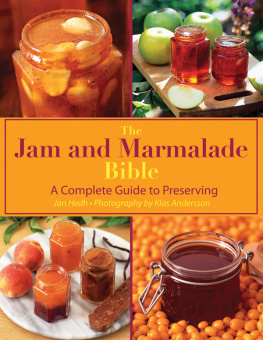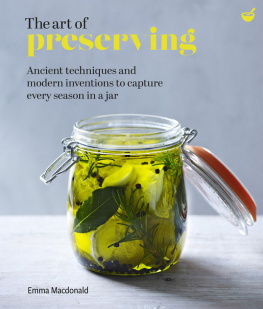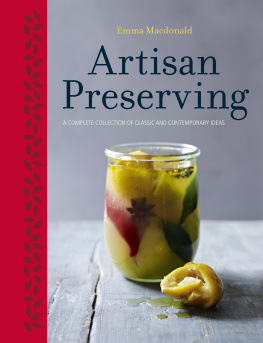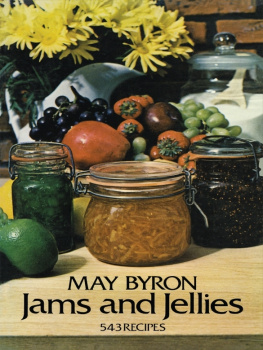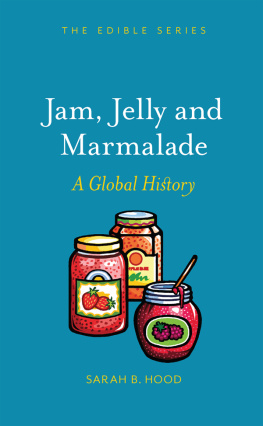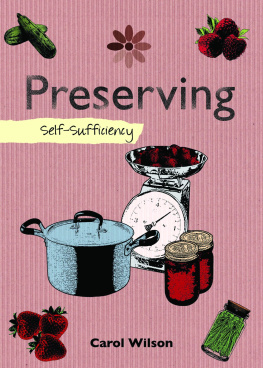
THE JAM AND MARMALADE BIBLE


Jan Hedh
Photography by Klas Andersson
The Jam
and
Marmalade
Bible
Translation by Stine Skarpnes Osttveit

SKYHORSE PUBLISHING
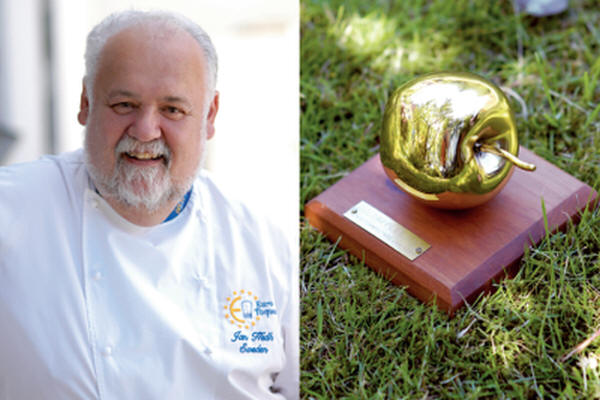
A large thank you to Magne Haugen for his eminent help with the photos.
Copyright 2012 by Jan Hedh
Photographs copyright 2012 by Klas Andersson
Originally published in Sweden by Prisma as Sylt och marmelad
Translation 2012 by Stine Skarpnes Osttveit
All Rights Reserved. No part of this book may be reproduced in any manner without the express written consent of the publisher, except in the case of brief excerpts in critical reviews or articles. All inquiries should be addressed to Skyhorse Publishing, 307 West 36th Street, 11th Floor, New York, NY 10018.
Skyhorse Publishing books may be purchased in bulk at special discounts for sales promotion, corporate gifts, fund-raising, or educational purposes. Special editions can also be created to specifications. For details, contact the Special Sales Department, Skyhorse Publishing, 307 West 36th Street, 11th Floor, New York, NY 10018 or .
Skyhorse and Skyhorse Publishing are registered trademarks of Skyhorse Publishing, Inc., a Delaware corporation.
www.skyhorsepublishing.com
10 9 8 7 6 5 4 3 2 1
Library of Congress Cataloging-in-Publication Data is available on file.
ISBN 978-1-61608-606-0
Printed in China
,
,
,
, Classic Spices and
Added Flavors for Jam and Marmalade,
, Black
berries, ,
,
,
,
,
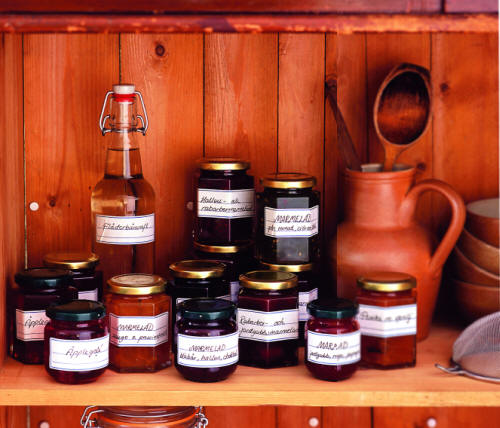
Foreword
The basements at both my grandmother and mothers houses were always fully stocked with jars of jam, pickled beets, onions, and cucumbers of every kindAsian cucumber, salt cucumber, and my mothers specialty, mustard cucumber with yellow mustard seeds that we preferably ate instantly. The jars were beautifully stacked on the shelves with handwritten labels and the date it was made. Their kitchens always had an aroma of juice and jam and they would make left-over juice with the berries that had been used for blackcurrant jellya ready-to-drink juice for everyday useso that not a single raw material was wasted. In the kitchen, juice would be slowly draining and the strong scent of vinegar from the pickled green tomatoes and onions pinched the nose.
As a child during the 50s I would always accompany my mother and grandmother to the market in Tomelilla and the Mllevngsmarket in Malm. They would inspect the raw materials and I would help carry them home to our kitchen. My mother would always make drottningssylt, a jam made out of raspberries and blueberries, for the rice pudding on Christmas eve, and my father needed blueberry jam for his thin and crispy pancakes. My mothers blackcurrant jelly would be served with the Sunday roast and roasted chicken. My father would go buy the meat and would loudly and clearly request which exact piece of meat he wanted.
Green tomato marmalade with ginger and cinnamon was served with a fresh pot of tea and my mothers tasty graham crackers. My mother was very talented in the kitchen and had been taught in a rectory as a young girl, which she often mentioned while she was baking or cooking in the kitchen. When we were really pulling out all the stops we would serve calf with a creamy sauce and marble potatoes and pickles with fresh parsley and jelly.
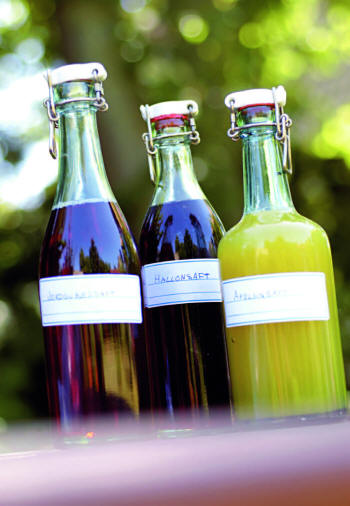
We would most often serve lingonberry jam with potato puffs, meatballs, and crispy spareribs. Small, beautiful beets would be served with the homemade Christmas pressed brawn and calf headcheese, that they would call bigat. A bottle of vinegar would always be placed on the table with these kinds of foods. You rarely see the bottle of vinegar on any dinner table these days, but in my parents home it would often be brought out, especially when we ate things like beans, eel, or catfish with horseradish sauce.
We would often eat lingonberry jam with cold milk as an everyday dessert, and on Saturdays and Sundays lingonberry pears and ginger pears would be served with whipped cream. Jam and whipped cream was a natural side to waffles and pancakes. French toast with applesauce, and pancakes with bacon with stirred cranberry jam made the mouth water. Lingonberry jam would also be served with stuffed cabbage rolls and cabbage pudding. When I think back on my childhood the scent of cooked foods in the kitchen is prevalent, and I also remember my parents discussing the quality of the ingredients available. They wanted the best-quality meats for the beef stew and good ground pork for meatballs and so on.
When I first began working at the Savoy in Malm, they would serve small pickled beets with the stuffed cabbage rolls, instead of cranberry jam, which is a combination I also very much enjoy. The Hotel Savoy in Malm had regulars such as Sten Broman, Fritiof Nilsson Piraten (the Pirate) and Bank Director Lindskog. These men loved traditional home-cooked foods, which were prepared perfectly under the supervision of the main chef Einar Petterson. Now and then we would serve Smlndsk cheesecake with redcurrant jam and lightly whipped cream, which tasted amazing. The cheesecake was delivered by train from a specialist in Smland to Malm central station. After the split-pea soup on Thursdays, we would serve pancakes with raspberry, cloudberry, or strawberry jam and lightly whipped cream for dessert.
When I first started out as a pastry chef apprentice I was fortunate enough to work in multiple places where many of these traditions were still in place. We would pickle and preserve orange peels and green, yellow, and red pears for the decoration of tarts and as an ingredient in frozen pudding that would be served with cotton candy. Pineapple slices would be worked into pralines and apricots were soaked in water and then boiled into jam, marmalade, or jelly. Applesauce and apple jelly, raspberry jam, strawberry jam, gooseberry jam, prune jam, and banana jam were often prepared and made use of in bakeries back then. Generous amounts of jam would be used for roll tarts, puffed pastries, biscuits, and thumb print cookies. A variety of compotes, like apple compote, prune compote, apricot compote, and plum compote would be served with pastries.
However, it was not until I travelled outside of Sweden that I would learn how to properly boil jam and marmalade the traditional way. In Switzerland and France the traditions were strong and the fruit and berries of high quality.
When we first started boiling jam and marmalade the traditional way at Olof Viktors bakery in Glemminge, Sweden, we experienced an instant success. Today, we boil about 400 jars daily in our jam boilery. Plum tomato marmalade with Tahiti vanilla and macaroon almonds is the most popular jam variety to eat with cheese, which it seems is what jam is most used for these days. At Hedh & Escalante Chocolatier in Malm they also boil many different kinds of chocolate marmalades and South American varieties.
Next page
